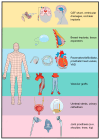Fluoroquinolones and Biofilm: A Narrative Review
- PMID: 39770514
- PMCID: PMC11679785
- DOI: 10.3390/ph17121673
Fluoroquinolones and Biofilm: A Narrative Review
Abstract
Background: Biofilm-associated infections frequently span multiple body sites and represent a significant clinical challenge, often requiring a multidisciplinary approach involving surgery and antimicrobial therapy. These infections are commonly healthcare-associated and frequently related to internal or external medical devices. The formation of biofilms complicates treatment, as they create environments that are difficult for most antimicrobial agents to penetrate. Fluoroquinolones play a critical role in the eradication of biofilm-related infections. Numerous studies have investigated the synergistic potential of combining fluoroquinolones with other chemical agents to augment their efficacy while minimizing potential toxicity. Comparative research suggests that the antibiofilm activity of fluoroquinolones is superior to that of beta-lactams and glycopeptides. However, their activity remains less effective than that of minocycline and fosfomycin. Noteworthy combinations include fluoroquinolones with fosfomycin and aminoglycosides for enhanced activity against Gram-negative organisms and fluoroquinolones with minocycline and rifampin for more effective treatment of Gram-positive infections. Despite the limitations of fluoroquinolones due to the intrinsic characteristics of this antibiotic, they remain fundamental in this setting thanks to their bioavailability and synergisms with other drugs. Methods: A comprehensive literature search was conducted using online databases (PubMed/MEDLINE/Google Scholar) and books written by experts in microbiology and infectious diseases to identify relevant studies on fluoroquinolones and biofilm. Results: This review critically assesses the role of fluoroquinolones in managing biofilm-associated infections in various clinical settings while also exploring the potential benefits of combination therapy with these antibiotics. Conclusions: The literature predominantly consists of in vitro studies, with limited in vivo investigations. Although real world data are scarce, they are in accordance with fluoroquinolones' effectiveness in managing early biofilm-associated infections. Also, future perspectives of newer treatment options to be placed alongside fluoroquinolones are discussed. This review underscores the role of fluoroquinolones in the setting of biofilm-associated infections, providing a comprehensive guide for physicians regarding the best use of this class of antibiotics while highlighting the existing critical issues.
Keywords: antibiotic therapy; biofilm; biofilm-forming infections; fluoroquinolone; fluoroquinolone and biofilm.
Conflict of interest statement
The authors declare no conflicts of interest.
Figures






Similar articles
-
An update on the management of urinary tract infections in the era of antimicrobial resistance.Postgrad Med. 2017 Mar;129(2):242-258. doi: 10.1080/00325481.2017.1246055. Epub 2016 Oct 21. Postgrad Med. 2017. PMID: 27712137 Review.
-
Hybrid combinations containing natural products and antimicrobial drugs that interfere with bacterial and fungal biofilms.Phytomedicine. 2017 Dec 15;37:14-26. doi: 10.1016/j.phymed.2017.10.021. Epub 2017 Nov 23. Phytomedicine. 2017. PMID: 29174600 Review.
-
Nitroxide Functionalized Antibiotics Are Promising Eradication Agents against Staphylococcus aureus Biofilms.Antimicrob Agents Chemother. 2019 Dec 20;64(1):e01685-19. doi: 10.1128/AAC.01685-19. Print 2019 Dec 20. Antimicrob Agents Chemother. 2019. PMID: 31636066 Free PMC article.
-
Antimicrobial effect of fluoroquinolones for the eradication of nontypeable Haemophilus influenzae isolates within biofilms.Tohoku J Exp Med. 2008 Feb;214(2):121-8. doi: 10.1620/tjem.214.121. Tohoku J Exp Med. 2008. PMID: 18285669
-
Bacteriophage-antibiotic combinations against ciprofloxacin/ceftriaxone-resistant Escherichia coli in vitro and in an experimental Galleria mellonella model.Int J Antimicrob Agents. 2020 Dec;56(6):106200. doi: 10.1016/j.ijantimicag.2020.106200. Epub 2020 Oct 17. Int J Antimicrob Agents. 2020. PMID: 33075514
Cited by
-
Rare or Unusual Non-Fermenting Gram-Negative Bacteria: Therapeutic Approach and Antibiotic Treatment Options.Antibiotics (Basel). 2025 Mar 16;14(3):306. doi: 10.3390/antibiotics14030306. Antibiotics (Basel). 2025. PMID: 40149115 Free PMC article. Review.
-
Staphylococcus aureus: A Review of the Pathogenesis and Virulence Mechanisms.Antibiotics (Basel). 2025 May 6;14(5):470. doi: 10.3390/antibiotics14050470. Antibiotics (Basel). 2025. PMID: 40426537 Free PMC article. Review.
-
Fluoroquinolones for Dermatologists: A Practical Guide to Clinical Use and Risk Management.Pharmaceuticals (Basel). 2025 May 26;18(6):800. doi: 10.3390/ph18060800. Pharmaceuticals (Basel). 2025. PMID: 40573197 Free PMC article. Review.
-
Targeting Staphylococcus aureus biofilm-related infections on implanted material with a novel dual-action thermosensitive hydrogel containing vancomycin and a tri-enzymatic cocktail: in vitro and in vivo studies.Biofilm. 2025 May 20;9:100288. doi: 10.1016/j.bioflm.2025.100288. eCollection 2025 Jun. Biofilm. 2025. PMID: 40496337 Free PMC article.
References
Publication types
LinkOut - more resources
Full Text Sources

